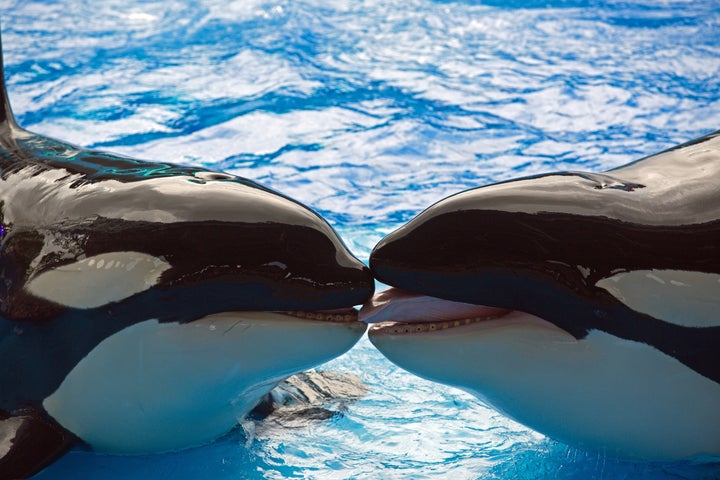
SeaWorld orca with drilled, damaged teeth visible during performances, USA. (I. N. Visser, Orca Research Trust)
Rot and decay of orca teeth is but a symptom of a far more menacing threat to orca in captivity.
SeaWorld’s orca — the inimitable ambassadors of the marine theme park’s captive cabaret where “wild” is but an illusion — face an unhealthy state of decline much like the industry itself. The severity and prevalence of dental pathology among captive orca is now prompting scientific scrutiny and animal welfare complaints.
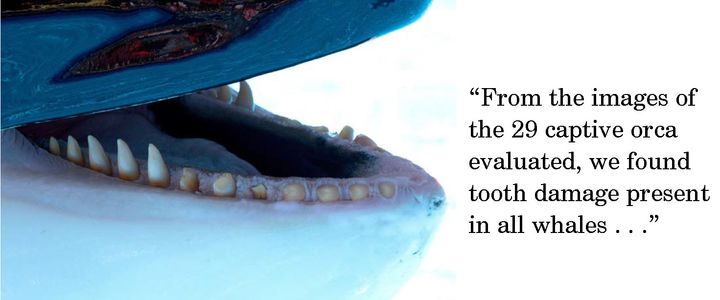
Damaged orca teeth, chipped, broken, worn to gums, USA. (I. N. Visser, Orca Research Trust)
In an earlier article, the observational focus was on the teeth of six SeaWorld orca held at Loro Parque, Tenerife, Spain. The basis was a report prepared by Dr. Ingrid Visser and Rosina Lisker of the Free Morgan Foundation who observed and photographed SeaWorld’s orca at Loro Parque in April 2016.
The images of the orca’s teeth at Loro Parque were hard to look at and induced widespread revulsion at the calculating cold heartedness with which Loro Parque dismissed the concerns that were raised.
Despite ever-increasing evidence that the commercial exploitation of these sentient beings serves no legitimate purpose; SeaWorld continues to mount toothless denials to justify keeping orca in captivity.
SeaWorld claimed their orca were happy and well-adjusted to life in captivity; then came the documentary Blackfish. SeaWorld claimed the dorsal fins of orca in the wild collapse just like 100% of all SeaWorld’s adult captive male orca; but the scientific literature does not bear this out. SeaWorld threatened to sue the State of California over the “right” to breed orca in captivity; then SeaWorld voluntarily agreed to end the captive breeding of all of its orca. SeaWorld told investors that anti-captivity campaigns have had no effect on its business; now SeaWorld is laying off 350 employees citing “public perception issues” for dropping attendance and its executives are under criminal investigation for misleading shareholders.
When the Visser & Lisker report came out, SeaWorld’s proxies in Loro Parque bumblingly dismissed the findings despite photographic documentation to the contrary:

Orca Morgan broken teeth, Spain. (I. N. Visser, Orca Research Trust)
Now, a new peer reviewed scientific paper, Tooth Damage in Captive Orcas, takes the discussion a step further. All 29 orca held captive by SeaWorld at its parks in the United States (San Diego, Orlando and San Antonio) and at Loro Parque (Tenerife Spain), were included in a first of its kind study of orca dentition in captivity.
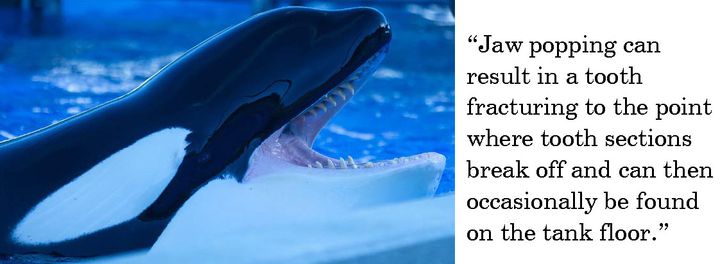
Upper and lower damaged orca teeth, USA. (I. N. Visser, Orca Research Trust)
Co-authored by former SeaWorld trainers Dr. John Jett and Dr. Jeffrey Ventre; orca biologist Dr. Ingrid Visser; cetacean dentition specialist Dr. Carolina Loch; and investigative researcher Jordan Waltz, the paper appears in the September 2017 Archives of Oral Biology, an international journal “which aims to publish papers of the highest scientific quality in the oral and craniofacial sciences.”
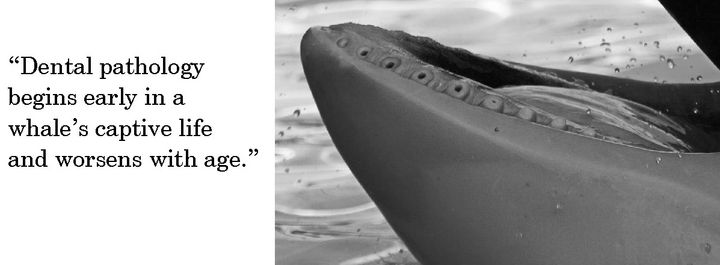
Orca teeth worn to the gums and drilled, USA. (I. N. Visser, Orca Research Trust)
The ramifications from the findings of this new scientific paper may prove to be the most damaging yet for the captive orca industry. Using high-resolution photographs, individual teeth in the mandible and maxilla of captive orca were scored for coronal wear, wear at or below the gum line, fractures, bore holes and if the teeth were missing altogether.
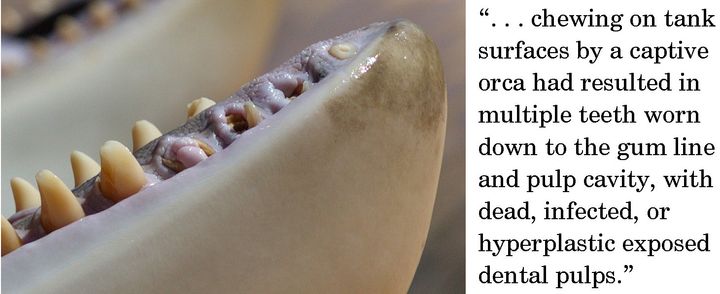
Damaged orca teeth, showing chips, cracks, bore holes and wear, Spain. (I. N. Visser, Orca Research Trust)
The results of this new peer reviewed scientific study are jaw dropping and cannot be ignored. Here is what the authors are saying:
“We investigated 29 orca owned by one company and held in the USA and Spain. Every whale had some form of damage to its teeth. . . more than 65% possessed moderate to extreme tooth wear in their lower jaws, mostly as a result of chewing concrete and steel tank surfaces.” (Dr. John Jett)
“. . . the teeth of captive orca are incredibly compromised and you just don’t see this type or level of damage in the wild.” (Dr. Ingrid Visser)
“. . . the damage to the teeth of these animals is so severe that most individuals can be identified by the specific fractures and tooth wear alone, much like forensic pathologists use for identification of humans post-mortem.” (Jordan Waltz)
“A drilled tooth is severely weakened and if any other trauma occurs, fractures will happen. We have documented more than 60% of the second and third teeth of the lower jaws were broken and this high number is likely linked to the drilling.” (Dr. Carolina Loch)
". . . teeth damage is the most tragic consequence of captivity, as it not only causes morbidity and mortality in captive orcas, but often leads to chronic antibiotic therapy compromising the whale's immune system, as we saw recently with the orca known as Kasatka.” (Dr. Jeffrey Ventre)
According to the authors, captivity-induced dental pathology among orca has been evident since at least the late 1980’s. But despite the animal welfare implications of tooth damage in captive orca, limited empirical research on the topic exists.
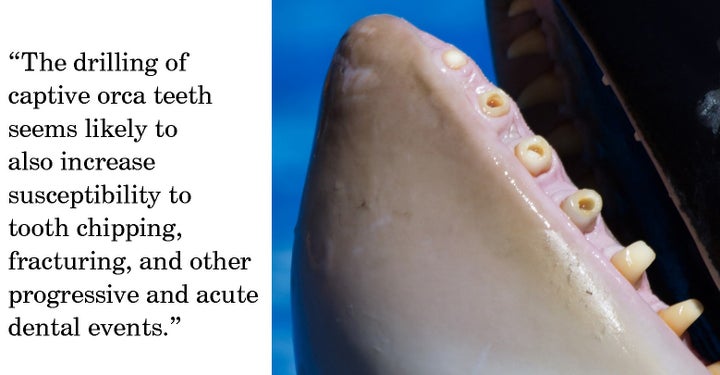
Damaged orca teeth, worn to the gum, missing, chipped & fractured, Spain. (I. N. Visser, Orca Research Trust)
Considering nearly one-half of all the orca held in captivity are under SeaWorld’s care, the fact that SeaWorld itself has not published any peer reviewed or substantive scientific papers on the subject is hard to defend – maybe it can – but it hasn’t yet.
Facilitating this growing animal welfare scandal and acting as spectators of indifference rather than agents of change is the captive orca industry itself as well as government regulators like the US Department of Agriculture’s Animal and Plant Health Inspection Service (APHIS).
Compromising ethics and morals and sacrificing honesty and accountability in defense of corporate interests and shareholder profit, should never trump the welfare of any animal held in captivity in an advanced, enlightened and humane society.
As the authors of the paper note, SeaWorld is in a unique position to advance our knowledge and insight into this phenomenon by making dental and health records publicly available to independent researchers.
The common thread throughout is the welfare of SeaWorld’s orca. With that goal, a commitment to transparency by SeaWorld is long overdue.
#SeaWorld, #Blackfish, #KillerWhales, #Orca, #AnimalWelfare, #Captivity, #Science
*Authors note: Matthew Spiegl serves on the Board of Directors for the Free Morgan Foundation with Dr. Ingrid Visser, a co-author of the above referenced scientific paper.
